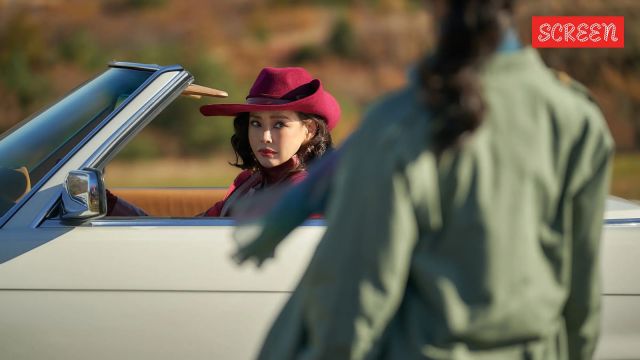Click here to follow Screen Digital on YouTube and stay updated with the latest from the world of cinema.
Netflix’s Aema: The real story of Korea’s most ‘scandalous darling’ and the birth of its first adult film
Netflix’s Aema set in Korea’s 80s film world, where actor Jeong Hee Ran rebelled against nude roles, only to be sidelined in her own movie. Inspired by the real Madame Aema.
 Madame Aema: the movie that shocked 80s Korea
Madame Aema: the movie that shocked 80s KoreaK-drama Aema, which debuted on August 22, has become one of the most talked-about Netflix shows, largely because it is based on the true story of “the darling” of Korea’s film industry. Set in the 80s, it follows actor Jeong Hee Ran in the days leading up to what should have been her big moment, signing her last film under Shinsung Pictures and ending her exclusive contract. But instead, she finds herself rebelling against demands for nudity and the brutal grip of the industry, only to be pushed into a supporting role in her own film.
Is K-drama Aema based on real-life events?
Aema tells the story of a group of unlikely people: a tired veteran actress, a sleazy studio owner, a rookie willing to go lengths and a bold nightclub dancer. Even though the drama uses fictional characters, it is directly inspired by a real movie from 1982: Madame Aema, Korea’s first erotic film. In the K-drama, Lee Ha Nee (Honey Lee) plays Jeong Hee Ran, a top star who is tired and done with always being typecast into nude or over-sexualised roles and wants to explore more serious roles. Her contract with the agency is about to end, and her last project is Madame Aema. But, right before she takes a huge risk of saying “No” to the nude roles. In a press statement, Jeong said that from now on, she will only consider nudity-free roles.
The decision didn’t sit well with the greedy studio head Ku Jung Ho (Uprising’s Jin Sun Kyu), who replaced her with a new actor, Shin Ju Ae (Bang Hyo Rin). Ju Se is ambitious and willing to do nudity scenes to climb the success ladder in the industry. After impressing rookie director Kwak In u (Cho Hyun Chul) with a tap dance audition, she lands the lead role, and Jeong was pushed to play the supporting role in the same movie. Initially, the two stars clashed on sets and treated each other as competitors, but over time, they formed an uneasy bond. The duo united against an industry and society dominated by men.
The movie takes place in the early 1980s, during Chun Doo Hwan’s military dictatorship. It was also the time when the country was trying to modernise itself, ahead of the 1988 Seoul Olympics, while hiding a brutal reality of political violence. The government was brutal, and pro-democratic movements were silenced. To distract the public, Chun pushed a “3S” policy — sex, screen, and sports. Erotic films were not only allowed but also encouraged. That’s how Madam Aema was made.
Madame Aema’s Success
When Madame Aema was released, it shocked the Korean public with how explicit it was for its time. Actor Ahn So Young played Oh Su Bi, a woman with multiple lovers while her husband was away. One scene, where she rides a horse nude, became the defining image of the movie. The film was a massive box office hit, selling over 100,000 tickets in Seoul alone. It went on to have 12 direct sequels and more than 16 spin-offs and remakes. The movie started Korea’s “ero film” era, named after Japan’s term for erotic cinema.
Most of the film industry at that time was based in Chungmuro in Seoul. It was Korea’s version of Hollywood. Later, the movie industry shifted to Gangnam. But, even today, top Korean stars like Song Kang Ho or Lee Byung Hyun are referred to as Chungmuro actors. While Aema is based on the true history of Madame Aema, it also mixes some fiction elements, characters and dramatic moments.
For instance, in the show, Jeong is shown as having starred in older “hostess films” (a popular 1970s Korean genre about bar girls or prostitutes). Posters from those films, like Yeong Ja’s Heydays (1975), also appear in the drama as references. Director Lee Hae Young, in a press statement, said, “(Madame) Aema was an icon that embodied the desires of the times and the desires of the masses in the 1980s.” However, the goal was to use this famous moment to explore bigger ideas. “But to have lived through that era as Aema meant constantly confronting and enduring deep prejudices and violent misunderstandings. That’s why, when I conceived this story, I thought of it as a way to support and give voice to the endurance of those who lived as Aema during that era.”
The name Madame Aema was inspired by the French erotic film Emmanuelle (1974). These kinds of movies were part of bigger European trends at the time. Netflix’s K-drama tries to connect the past with the present. The corruption, power abuse, and “anything-for-profit” attitude shown in the 80s still feels familiar today.


- 01
- 02
- 03
- 04
- 05
































